HYUNDAI PALISADE 2022 Owners Manual
Manufacturer: HYUNDAI, Model Year: 2022, Model line: PALISADE, Model: HYUNDAI PALISADE 2022Pages: 663, PDF Size: 15.74 MB
Page 401 of 663
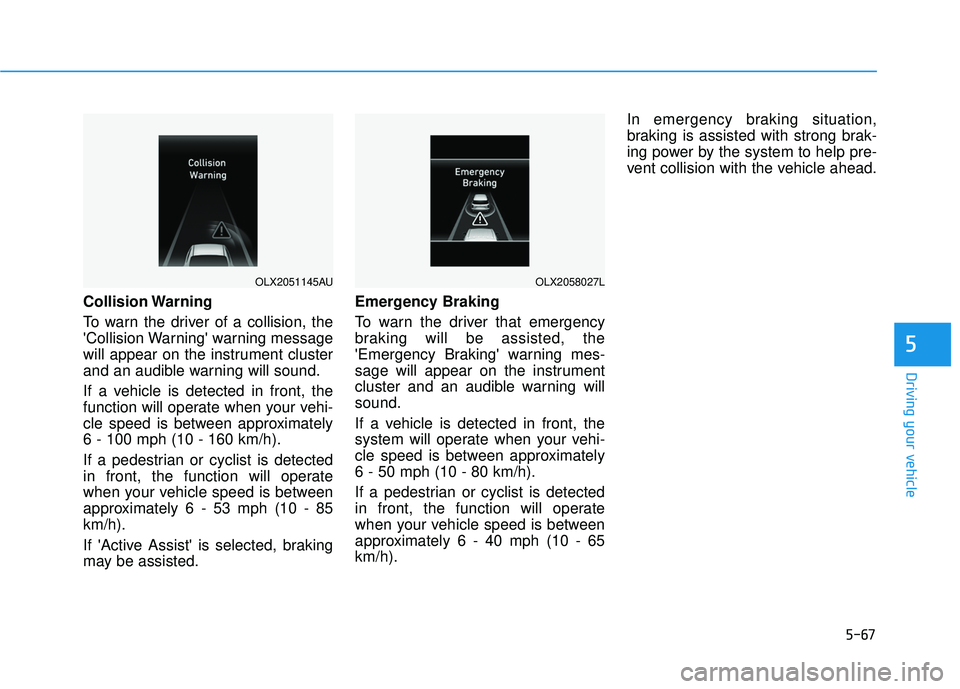
5-67
Driving your vehicle
5
Collision Warning
To warn the driver of a collision, the
'Collision Warning' warning message
will appear on the instrument cluster
and an audible warning will sound.
If a vehicle is detected in front, the
function will operate when your vehi-
cle speed is between approximately
6 - 100 mph (10 - 160 km/h).
If a pedestrian or cyclist is detected
in front, the function will operate
when your vehicle speed is between
approximately 6 - 53 mph (10 - 85
km/h).
If 'Active Assist' is selected, braking
may be assisted.Emergency Braking
To warn the driver that emergency
braking will be assisted, the
'Emergency Braking' warning mes-
sage will appear on the instrument
cluster and an audible warning will
sound.
If a vehicle is detected in front, the
system will operate when your vehi-
cle speed is between approximately
6 - 50 mph (10 - 80 km/h).
If a pedestrian or cyclist is detected
in front, the function will operate
when your vehicle speed is between
approximately 6 - 40 mph (10 - 65
km/h).In emergency braking situation,
braking is assisted with strong brak-
ing power by the system to help pre-
vent collision with the vehicle ahead.
OLX2051145AUOLX2058027L
Page 402 of 663
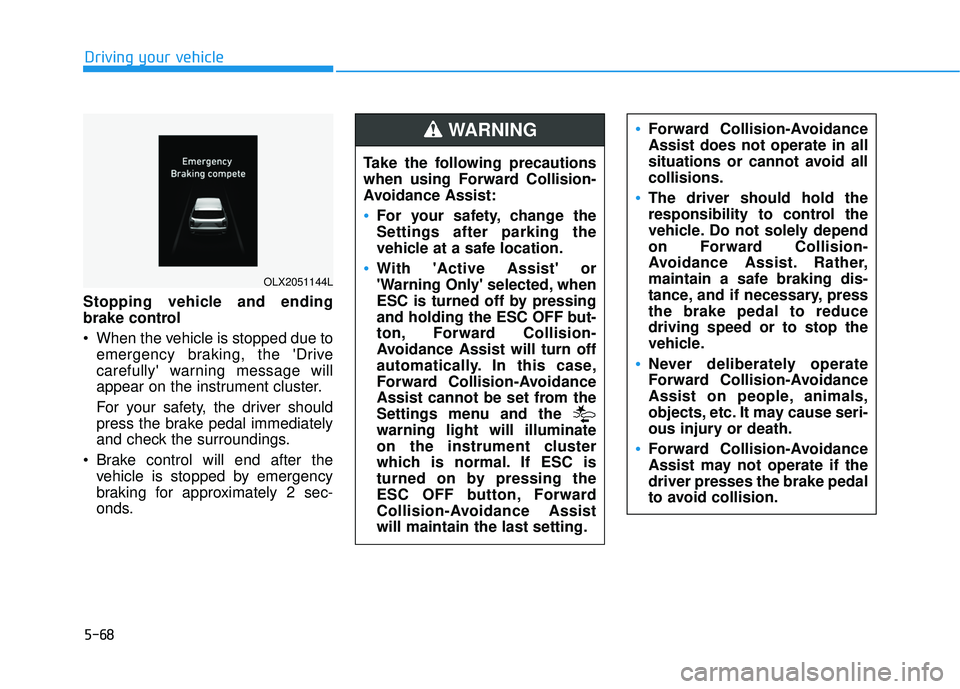
5-68
Driving your vehicle
Stopping vehicle and ending
brake control
When the vehicle is stopped due to emergency braking, the 'Drive
carefully' warning message will
appear on the instrument cluster.
For your safety, the driver should
press the brake pedal immediately
and check the surroundings.
Brake control will end after the vehicle is stopped by emergency
braking for approximately 2 sec-
onds.
OLX2051144L
Take the following precautions
when using Forward Collision-
Avoidance Assist:
For your safety, change the
Settings after parking the
vehicle at a safe location.
With 'Active Assist' or
'Warning Only' selected, when
ESC is turned off by pressing
and holding the ESC OFF but-
ton, Forward Collision-
Avoidance Assist will turn off
automatically. In this case,
Forward Collision-Avoidance
Assist cannot be set from the
Settings menu and the
warning light will illuminate
on the instrument cluster
which is normal. If ESC is
turned on by pressing the
ESC OFF button, Forward
Collision-Avoidance Assist
will maintain the last setting.
Forward Collision-Avoidance
Assist does not operate in all
situations or cannot avoid all
collisions.
The driver should hold the
responsibility to control the
vehicle. Do not solely depend
on Forward Collision-
Avoidance Assist. Rather,
maintain a safe braking dis-
tance, and if necessary, press
the brake pedal to reduce
driving speed or to stop the
vehicle.
Never deliberately operate
Forward Collision-Avoidance
Assist on people, animals,
objects, etc. It may cause seri-
ous injury or death.
Forward Collision-Avoidance
Assist may not operate if the
driver presses the brake pedal
to avoid collision.
WARNING
Page 403 of 663
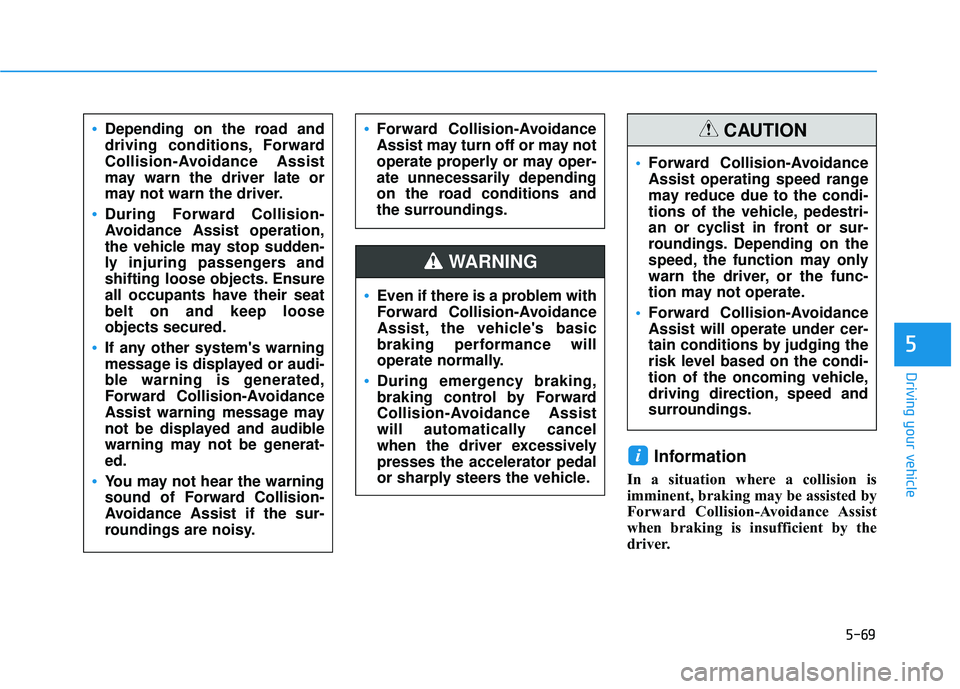
5-69
Driving your vehicle
5
Information
In a situation where a collision is
imminent, braking may be assisted by
Forward Collision-Avoidance Assist
when braking is insufficient by the
driver.
i
Depending on the road and
driving conditions, Forward
Collision-Avoidance Assist
may warn the driver late or
may not warn the driver.
During Forward Collision-
Avoidance Assist operation,
the vehicle may stop sudden-
ly injuring passengers and
shifting loose objects. Ensure
all occupants have their seat
belt on and keep loose
objects secured.
If any other system's warning
message is displayed or audi-
ble warning is generated,
Forward Collision-Avoidance
Assist warning message may
not be displayed and audible
warning may not be generat-
ed.
You may not hear the warning
sound of Forward Collision-
Avoidance Assist if the sur-
roundings are noisy.
Forward Collision-Avoidance
Assist may turn off or may not
operate properly or may oper-
ate unnecessarily depending
on the road conditions and
the surroundings.
Even if there is a problem with
Forward Collision-Avoidance
Assist, the vehicle's basic
braking performance will
operate normally.
During emergency braking,
braking control by Forward
Collision-Avoidance Assist
will automatically cancel
when the driver excessively
presses the accelerator pedal
or sharply steers the vehicle.
WARNING
Forward Collision-Avoidance
Assist operating speed range
may reduce due to the condi-
tions of the vehicle, pedestri-
an or cyclist in front or sur-
roundings. Depending on the
speed, the function may only
warn the driver, or the func-
tion may not operate.
Forward Collision-Avoidance
Assist will operate under cer-
tain conditions by judging the
risk level based on the condi-
tion of the oncoming vehicle,
driving direction, speed and
surroundings.
CAUTION
Page 404 of 663
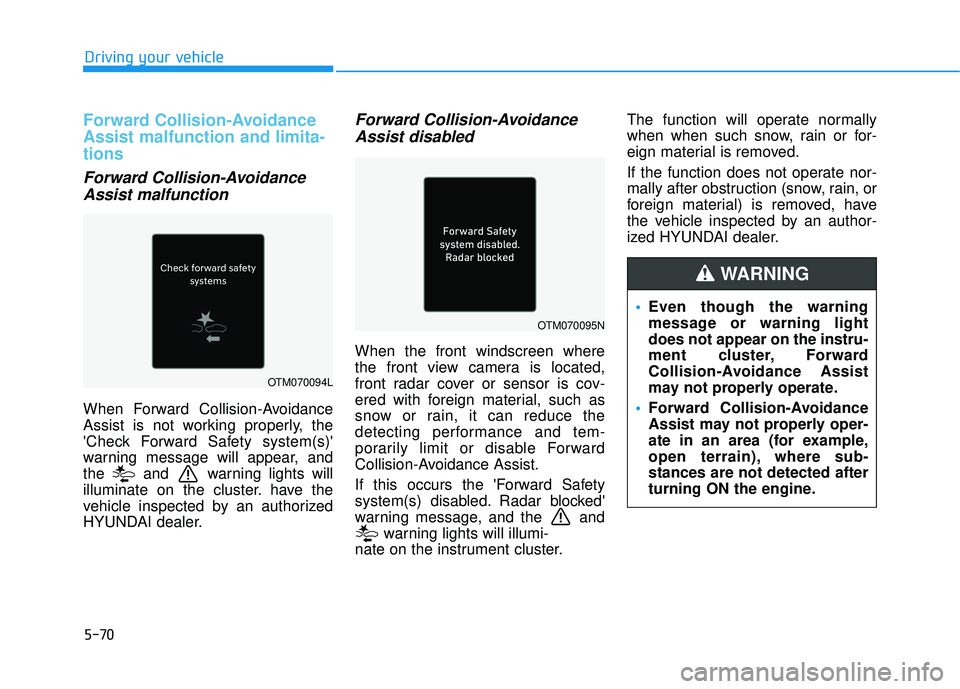
5-70
Driving your vehicle
Forward Collision-Avoidance
Assist malfunction and limita-
tions
Forward Collision-AvoidanceAssist malfunction
When Forward Collision-Avoidance
Assist is not working properly, the
'Check Forward Safety system(s)'
warning message will appear, and
the and warning lights will
illuminate on the cluster. have the
vehicle inspected by an authorized
HYUNDAI dealer.
Forward Collision-AvoidanceAssist disabled
When the front windscreen where
the front view camera is located,
front radar cover or sensor is cov-
ered with foreign material, such as
snow or rain, it can reduce the
detecting performance and tem-
porarily limit or disable Forward
Collision-Avoidance Assist.
If this occurs the 'Forward Safety
system(s) disabled. Radar blocked'
warning message, and the and
warning lights will illumi-
nate on the instrument cluster. The function will operate normally
when when such snow, rain or for-
eign material is removed.
If the function does not operate nor-
mally after obstruction (snow, rain, or
foreign material) is removed, have
the vehicle inspected by an author-
ized HYUNDAI dealer.
OTM070094L
OTM070095N
Even though the warning
message or warning light
does not appear on the instru-
ment cluster, Forward
Collision-Avoidance Assist
may not properly operate.
Forward Collision-Avoidance
Assist may not properly oper-
ate in an area (for example,
open terrain), where sub-
stances are not detected after
turning ON the engine.
WARNING
Page 405 of 663
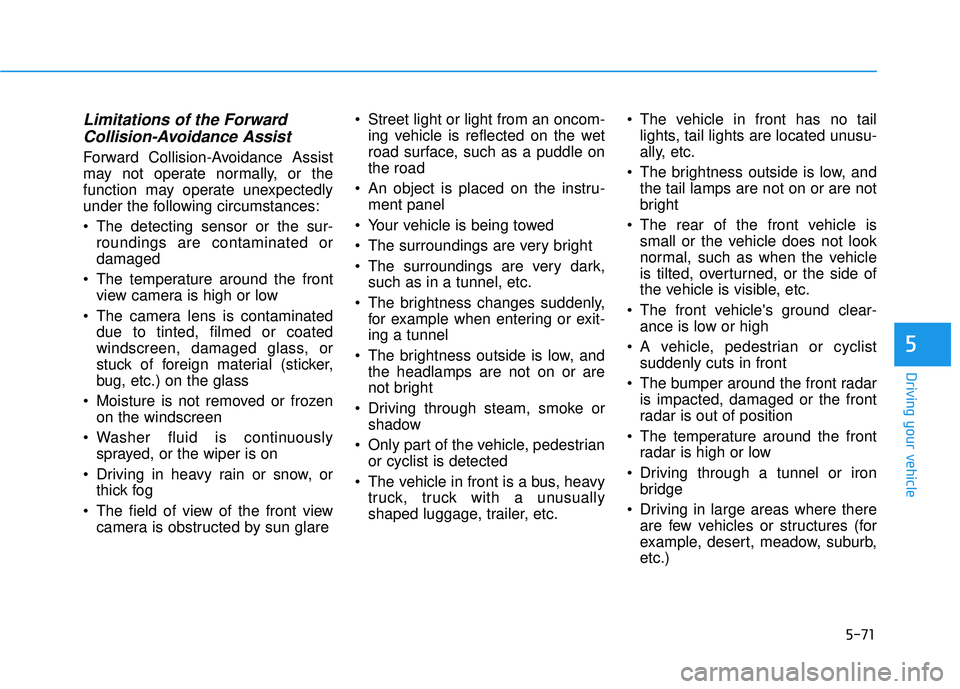
5-71
Driving your vehicle
5
Limitations of the ForwardCollision-Avoidance Assist
Forward Collision-Avoidance Assist
may not operate normally, or the
function may operate unexpectedly
under the following circumstances:
The detecting sensor or the sur-
roundings are contaminated or
damaged
The temperature around the front view camera is high or low
The camera lens is contaminated due to tinted, filmed or coated
windscreen, damaged glass, or
stuck of foreign material (sticker,
bug, etc.) on the glass
Moisture is not removed or frozen on the windscreen
Washer fluid is continuously sprayed, or the wiper is on
Driving in heavy rain or snow, or thick fog
The field of view of the front view camera is obstructed by sun glare Street light or light from an oncom-
ing vehicle is reflected on the wet
road surface, such as a puddle on
the road
An object is placed on the instru- ment panel
Your vehicle is being towed
The surroundings are very bright
The surroundings are very dark, such as in a tunnel, etc.
The brightness changes suddenly, for example when entering or exit-
ing a tunnel
The brightness outside is low, and the headlamps are not on or are
not bright
Driving through steam, smoke or shadow
Only part of the vehicle, pedestrian or cyclist is detected
The vehicle in front is a bus, heavy truck, truck with a unusually
shaped luggage, trailer, etc. The vehicle in front has no tail
lights, tail lights are located unusu-
ally, etc.
The brightness outside is low, and the tail lamps are not on or are not
bright
The rear of the front vehicle is small or the vehicle does not look
normal, such as when the vehicle
is tilted, overturned, or the side of
the vehicle is visible, etc.
The front vehicle's ground clear- ance is low or high
A vehicle, pedestrian or cyclist suddenly cuts in front
The bumper around the front radar is impacted, damaged or the front
radar is out of position
The temperature around the front radar is high or low
Driving through a tunnel or iron bridge
Driving in large areas where there are few vehicles or structures (for
example, desert, meadow, suburb,
etc.)
Page 406 of 663
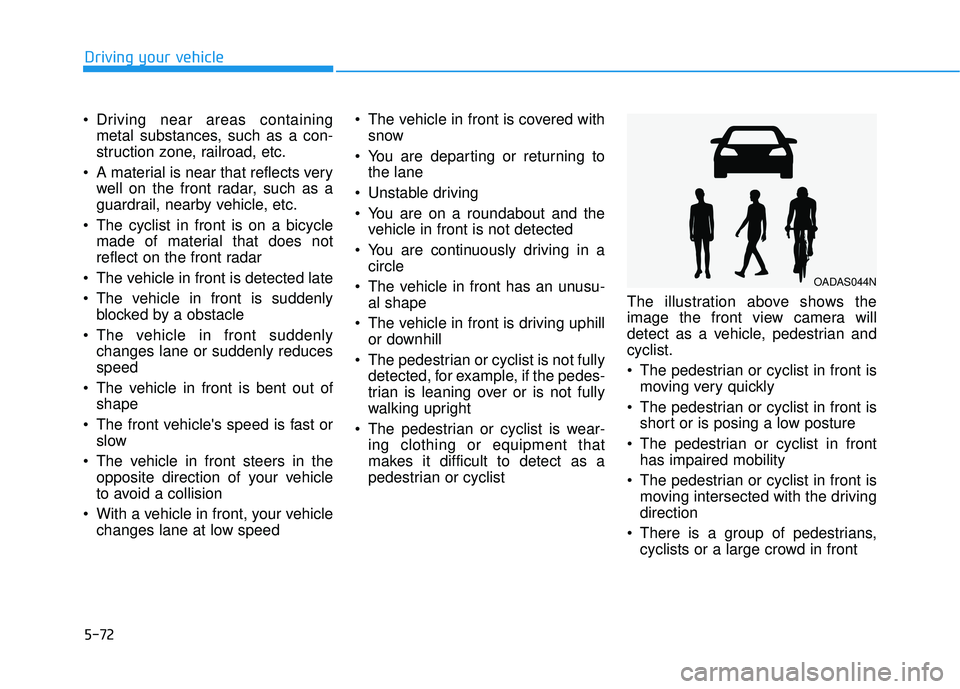
5-72
Driving your vehicle
Driving near areas containing metal substances, such as a con-
struction zone, railroad, etc.
A material is near that reflects very well on the front radar, such as a
guardrail, nearby vehicle, etc.
The cyclist in front is on a bicycle made of material that does not
reflect on the front radar
The vehicle in front is detected late
The vehicle in front is suddenly blocked by a obstacle
The vehicle in front suddenly changes lane or suddenly reduces
speed
The vehicle in front is bent out of shape
The front vehicle's speed is fast or slow
The vehicle in front steers in the opposite direction of your vehicle
to avoid a collision
With a vehicle in front, your vehicle changes lane at low speed The vehicle in front is covered with
snow
You are departing or returning to the lane
Unstable driving
You are on a roundabout and the vehicle in front is not detected
You are continuously driving in a circle
The vehicle in front has an unusu- al shape
The vehicle in front is driving uphill or downhill
The pedestrian or cyclist is not fully detected, for example, if the pedes-
trian is leaning over or is not fully
walking upright
The pedestrian or cyclist is wear- ing clothing or equipment that
makes it difficult to detect as a
pedestrian or cyclist The illustration above shows the
image the front view camera will
detect as a vehicle, pedestrian and
cyclist.
The pedestrian or cyclist in front is
moving very quickly
The pedestrian or cyclist in front is short or is posing a low posture
The pedestrian or cyclist in front has impaired mobility
The pedestrian or cyclist in front is moving intersected with the driving
direction
There is a group of pedestrians, cyclists or a large crowd in front
OADAS044N
Page 407 of 663
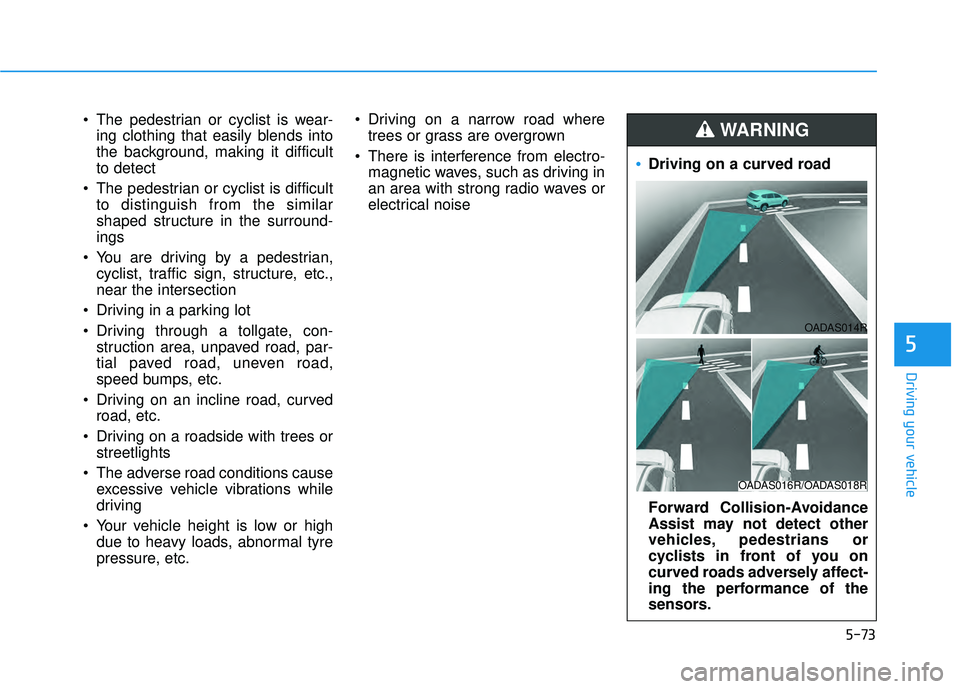
5-73
Driving your vehicle
5
The pedestrian or cyclist is wear-ing clothing that easily blends into
the background, making it difficult
to detect
The pedestrian or cyclist is difficult to distinguish from the similar
shaped structure in the surround-
ings
You are driving by a pedestrian, cyclist, traffic sign, structure, etc.,
near the intersection
Driving in a parking lot
Driving through a tollgate, con- struction area, unpaved road, par-
tial paved road, uneven road,
speed bumps, etc.
Driving on an incline road, curved road, etc.
Driving on a roadside with trees or streetlights
The adverse road conditions cause excessive vehicle vibrations while
driving
Your vehicle height is low or high due to heavy loads, abnormal tyre
pressure, etc. Driving on a narrow road where
trees or grass are overgrown
There is interference from electro- magnetic waves, such as driving in
an area with strong radio waves or
electrical noise
Driving on a curved road
Forward Collision-Avoidance
Assist may not detect other
vehicles, pedestrians or
cyclists in front of you on
curved roads adversely affect-
ing the performance of the
sensors.
WARNING
OADAS016R/OADAS018R
OADAS014R
Page 408 of 663
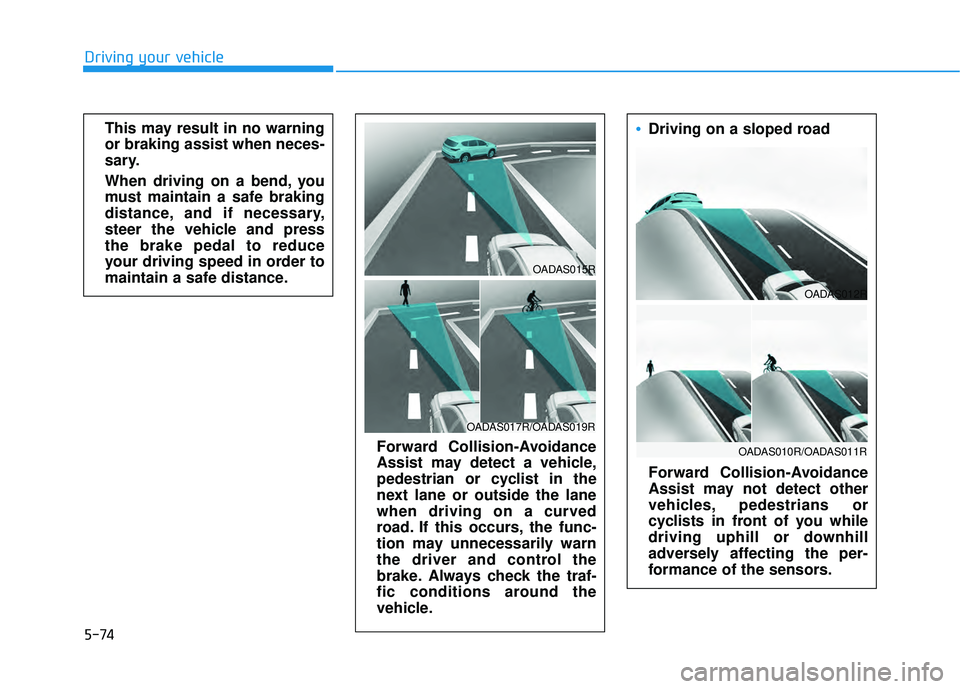
5-74
Driving your vehicleThis may result in no warning
or braking assist when neces-
sary.
When driving on a bend, you
must maintain a safe braking
distance, and if necessary,
steer the vehicle and press
the brake pedal to reduce
your driving speed in order to
maintain a safe distance.
Forward Collision-Avoidance
Assist may detect a vehicle,
pedestrian or cyclist in the
next lane or outside the lane
when driving on a curved
road. If this occurs, the func-
tion may unnecessarily warn
the driver and control the
brake. Always check the traf-
fic conditions around the
vehicle.
OADAS017R/OADAS019R
OADAS015R
Driving on a sloped road
Forward Collision-Avoidance
Assist may not detect other
vehicles, pedestrians or
cyclists in front of you while
driving uphill or downhill
adversely affecting the per-
formance of the sensors.
OADAS010R/OADAS011R
OADAS012R
Page 409 of 663
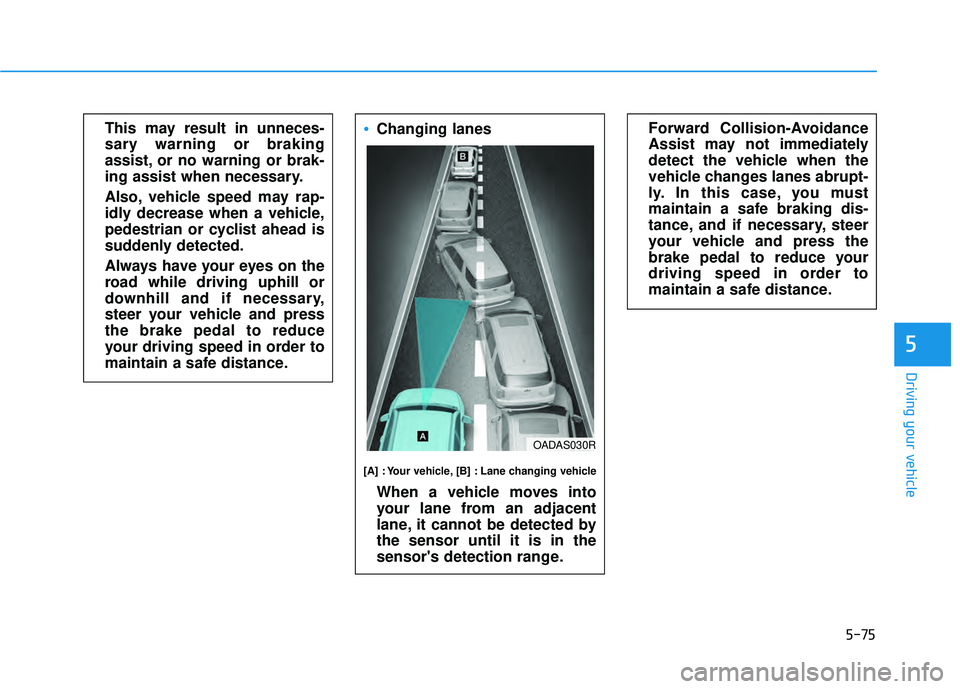
5-75
Driving your vehicle
5
This may result in unneces-
sary warning or braking
assist, or no warning or brak-
ing assist when necessary.
Also, vehicle speed may rap-
idly decrease when a vehicle,
pedestrian or cyclist ahead is
suddenly detected.
Always have your eyes on the
road while driving uphill or
downhill and if necessary,
steer your vehicle and press
the brake pedal to reduce
your driving speed in order to
maintain a safe distance.Changing lanes
[A] : Your vehicle, [B] : Lane changing vehicle
When a vehicle moves into
your lane from an adjacent
lane, it cannot be detected by
the sensor until it is in the
sensor's detection range.
OADAS030R
Forward Collision-Avoidance
Assist may not immediately
detect the vehicle when the
vehicle changes lanes abrupt-
ly. In this case, you must
maintain a safe braking dis-
tance, and if necessary, steer
your vehicle and press the
brake pedal to reduce your
driving speed in order to
maintain a safe distance.
Page 410 of 663
![HYUNDAI PALISADE 2022 Owners Manual Driving your vehicle
5-76
[A] : Your vehicle, [B] : Lane changing vehicle,
[C] : Same lane vehicle
When a vehicle in front of you
merges out of the lane,
Forward Collision-Avoidance
Assist may not imm HYUNDAI PALISADE 2022 Owners Manual Driving your vehicle
5-76
[A] : Your vehicle, [B] : Lane changing vehicle,
[C] : Same lane vehicle
When a vehicle in front of you
merges out of the lane,
Forward Collision-Avoidance
Assist may not imm](/img/35/41170/w960_41170-409.png)
Driving your vehicle
5-76
[A] : Your vehicle, [B] : Lane changing vehicle,
[C] : Same lane vehicle
When a vehicle in front of you
merges out of the lane,
Forward Collision-Avoidance
Assist may not immediately
detect the vehicle that is now
in front of you.
OADAS031R
In this case, you must main-
tain a safe braking distance,
and if necessary, steer your
vehicle and press the brake
pedal to reduce your driving
speed in order to maintain a
safe distance.Detecting vehicle
If the vehicle in front of you
has cargo that extends rear-
ward from the cab, or when
the vehicle in front of you has
higher ground clearance,
additional special attention is
required. Forward Collision-
Avoidance Assist may not be
able to detect the cargo
extending from the vehicle. In
these instances, you must
maintain a safe braking dis-
tance from the rearmost
object, and if necessary, steer
your vehicle and press the
brake pedal to reduce your
driving speed in order to
maintain distance.
OLX2051077N